Wednesday night was packed with data analysis tips, an ALS ice bucket challenge, and a very packed room, thanks to a DigiCert sponsorship. The last several events have seen a very good turnout, and as always the SLCSEM board lined up a very impressive cast of presenters.
Check it out - you can watch all three videos on Youtube!
Brian Trzupek, VP of Strategic Products at DigiCert
The Intersection of SSL and SEO (and a new tool announcement!)
 Brian spoke about
Brian spoke about
Google's announcement on August 6 revealing that HTTPS encryption (accomplished with a valid SSL certificate) is a ranking signal they are already considering. Google had this to say about the new ranking factor, which is a part of the
HTTPS Everywhere initiative:
"...over the past few months we’ve been running tests taking into account whether sites use secure, encrypted connections as a signal in our search ranking algorithms. We’ve seen positive results, so we’re starting to use HTTPS as a ranking signal. For now it's only a very lightweight signal—affecting fewer than 1% of global queries, and carrying less weight than other signals such as
high-quality content—while we give webmasters time to switch to HTTPS. But over time, we may decide to strengthen it, because we’d like to encourage all website owners to switch from HTTP to HTTPS to keep everyone safe on the web." -
Webmaster Central Blog
Brian emphasized the growing need for SEO teams and agencies to enable SSL on the websites that they optimize for ranking success, and to make sure that competitors aren't getting an edge that is very easy for anyone to take advantage of. Brian and the DigiCert team announced the release of their
DigiCert® Always-On SSL Site Checker, a very handy tool that lets you check how many domains rank for any given search query:
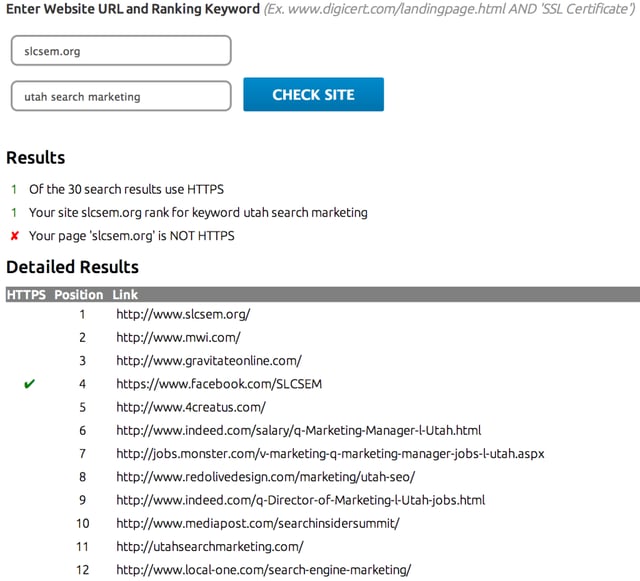 Follow DigiCert on twitter:
Follow DigiCert on twitter:
@digicert
Joe Martin, Manager, Adobe Digital Index Team
Using Data to Drive Strategy
 The second keynote was by Joe Martin of the Adobe Digital Index team, and was packed with examples of winning content strategies that capitalize on Adobe's big data sets. Joe mentioned that Adobe handles 6 out of 10 online sales, which means he has a gargantuan data set to play with, and he and his team are using it in some very exciting ways.
The second keynote was by Joe Martin of the Adobe Digital Index team, and was packed with examples of winning content strategies that capitalize on Adobe's big data sets. Joe mentioned that Adobe handles 6 out of 10 online sales, which means he has a gargantuan data set to play with, and he and his team are using it in some very exciting ways.
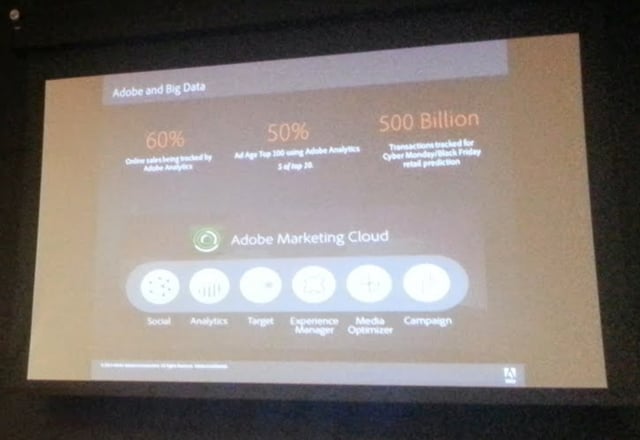 He started out though by saying that it doesn't take access to huge data sets to use data for content and traffic generation strategies. His own personal blog initially started out with virtually zero monthly page views, so he spent $100/mo driving traffic to the blog and working with that tiny data set to understand user behavior. He adapted the website based on what the data told him and things started getting "meta" when he saw significant traffic increases as he blogged about the analytics of his own blog.
He started out though by saying that it doesn't take access to huge data sets to use data for content and traffic generation strategies. His own personal blog initially started out with virtually zero monthly page views, so he spent $100/mo driving traffic to the blog and working with that tiny data set to understand user behavior. He adapted the website based on what the data told him and things started getting "meta" when he saw significant traffic increases as he blogged about the analytics of his own blog.

Content Strategies Evolve
Joe shared an anecdote from when the Adobe Index team was initially trying to improve Adobe Digital's brand recognition, they didn't hit a home run with their first strategy. As Joe proved with an informal poll of the audience, when we think about Adobe we think about Photoshop/CS/Acrobat - not Digital Marketing, so they had a challenge on their hands. Their initial content strategy was to produce some very in-depth whitepapers, offering them as downloads for form submissions, and saw only a fraction of the success they expected to see (100s of monthly downloads rather than 1000s).
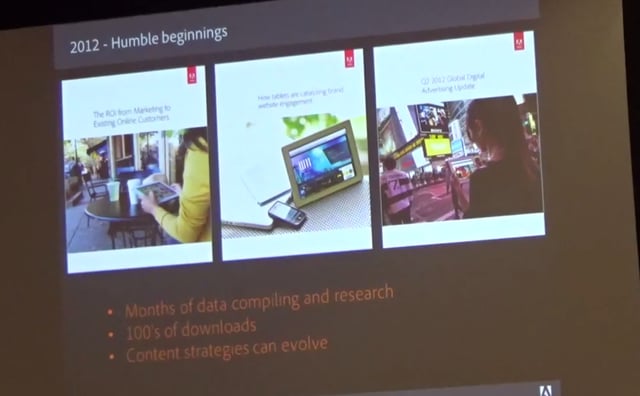 Their content strategy evolved into mining their data sets and publishing bold marketplace predictions and aggregate data trends, and they struck gold. The initial (unsuccessful) whitepaper strategy was launched in early 2012; fast forward to Thanksgiving, and the team used online consumer data to forecast Black Friday sales within 1% accuracy, earning media highlights nationwide, including some face time on CNBC to talk about it.
Their content strategy evolved into mining their data sets and publishing bold marketplace predictions and aggregate data trends, and they struck gold. The initial (unsuccessful) whitepaper strategy was launched in early 2012; fast forward to Thanksgiving, and the team used online consumer data to forecast Black Friday sales within 1% accuracy, earning media highlights nationwide, including some face time on CNBC to talk about it.
“Seize the opportunity. Look at the data you’re mining, and make the most of it” - Joe Martin
Joe and his team also mined web traffic data as it correlated to Super Bowl ads, which sparked regular media mentions in the weeks surrounding the big game. The Digital Index team was able to show and publish which ads had the most success in driving traffic to the advertiser's websites, and which ads were not so successful.
"What we were able to prove was that website visits to advertisers [...] actually spiked quite a bit after the Super Bowl. So it shows that if goal to get traffic to your website from your Super Bowl ad, then it works"
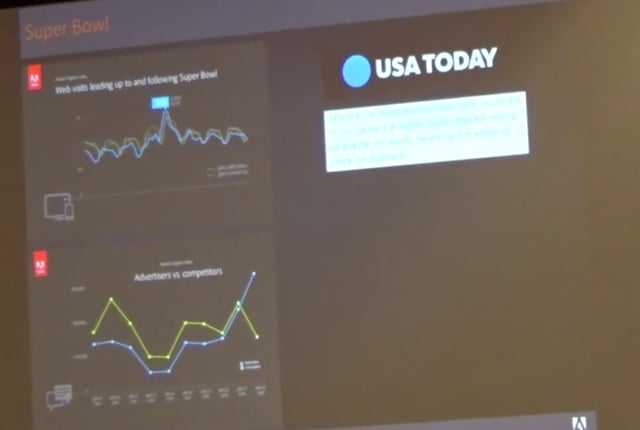 This data-mining-and-publishing strategy led to several successful outcomes:
This data-mining-and-publishing strategy led to several successful outcomes:
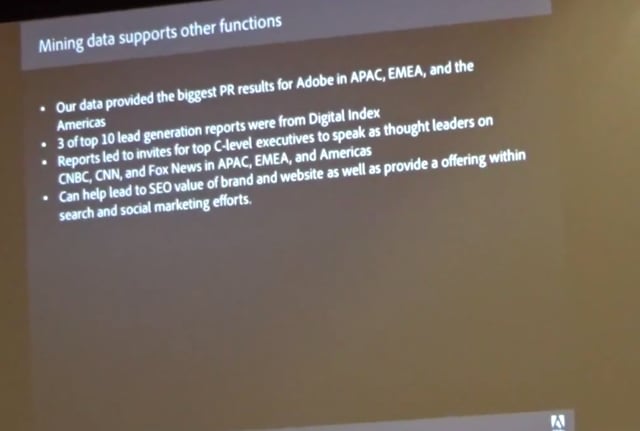 Now this data is impressive and all, but almost none of us have access to data sets that compare to Adobe's, so Joe brought up 5 data sources that virtually every company is
Now this data is impressive and all, but almost none of us have access to data sets that compare to Adobe's, so Joe brought up 5 data sources that virtually every company is
already sitting on that we have no excuse to ignore in setting marketing and content strategy:
- Business Intelligence
- Web Analytics
- Marketing Research
- Community Threads
- Customer Stories
And finally, from Joe's recap slide, he recaps his own takeaways:
- Organize a content team
- Discover your unique data
- Create content strategy goals, SEO, Social, PR
- Start creating press outlet relationships
- Share your data discoveries with other groups to drive their business goals
Connect with Joe on Twitter (
@joeDmarti and
@Adobeindex).
J. Rhett Frandsen, SVP of Corporate Strategy, Rakuten Marketing (Formerly Media Forge)
Omni-Channel Data Analysis
 Rhett had some very interesting points on the importance of understanding cross-channel performance and attribution. It is a complex landscape but he and the Rakuten Marketing team are pioneering proper ways to understand multichannel data. He points out that many marketers see "channel-siloed reporting" that doesn't account for the contribution of other channels to any given purchase.
Rhett had some very interesting points on the importance of understanding cross-channel performance and attribution. It is a complex landscape but he and the Rakuten Marketing team are pioneering proper ways to understand multichannel data. He points out that many marketers see "channel-siloed reporting" that doesn't account for the contribution of other channels to any given purchase.
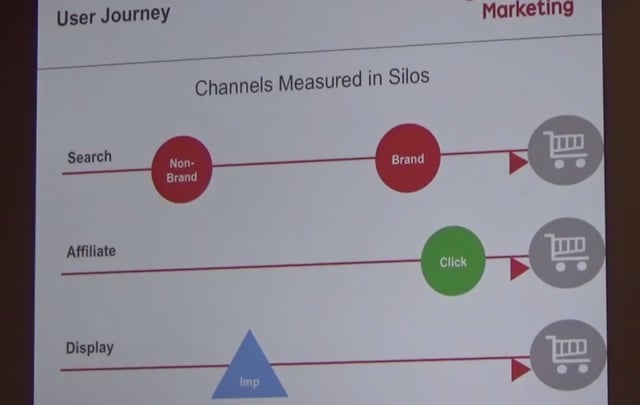 On the flip-side, many marketers look at multichannel reports and may overestimate the value of some channels. This is where omni-channel reporting can help to solve those problems.
On the flip-side, many marketers look at multichannel reports and may overestimate the value of some channels. This is where omni-channel reporting can help to solve those problems.
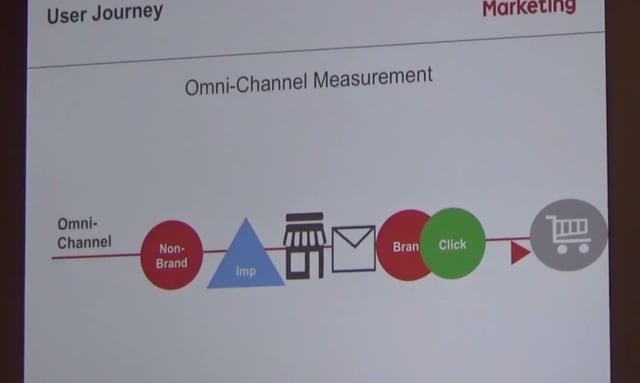 Rhett used this single example purchase as an illustrative example - this customer saw 28 touch points before making a single purchase, and most marketers will attribute that purchase to the
Rhett used this single example purchase as an illustrative example - this customer saw 28 touch points before making a single purchase, and most marketers will attribute that purchase to the
last touchpoint, which in this case was an email.
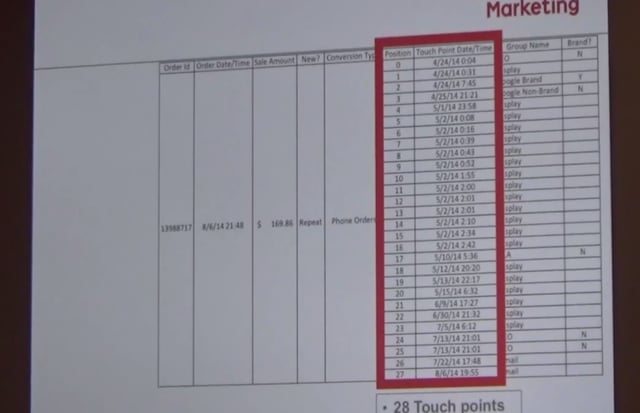 In this case, the email marketing team might try (unfairly) to claim all the success of the sale, much like the story of the
In this case, the email marketing team might try (unfairly) to claim all the success of the sale, much like the story of the
1980 NY Marathon winner, Rosie Ruiz, who actually took the subway for most of the route and joined the pack of runners at the end and easily sprinted to the finish.

Importance of distributing credit:
"This is what we're providing our search team and our display team and our affiliate team and all of our marketing services with, so that they can go to their advertisers and say 'Hey look, I want you to understand that I know I'm the best search vendor for you because I'm operating with a comprehensive view of all of your marketing initiatives, and I know that my marketing program is not just impacting in a silo, but how it's influencing or impacting or creating lift across all of your channels."
Rhett reminded the group of the importance of tracking new vs returning visitor touchpoints and understanding the difference between the two. Most companies place a higher priority on new customer growth, and their touchpoint path will likely look very different from that of a returning customer.
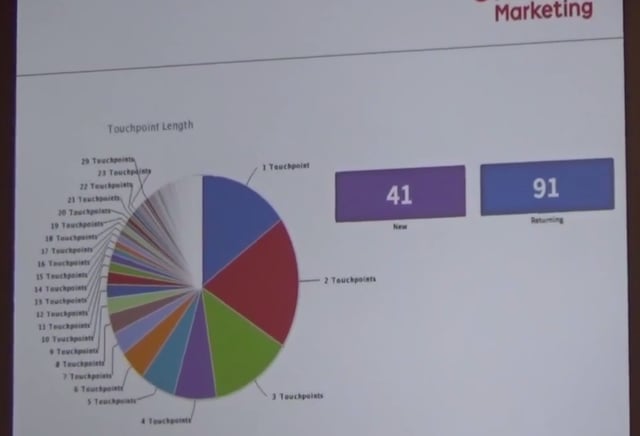
A lot of marketers and business owners try to tear channels apart and manage them differently, when we should be thinking about how each channel interplays with the next, and how to combine them for high conversion outcomes. He emphasized this point with the following slide which proves that conversions are higher when there is channel overlap:
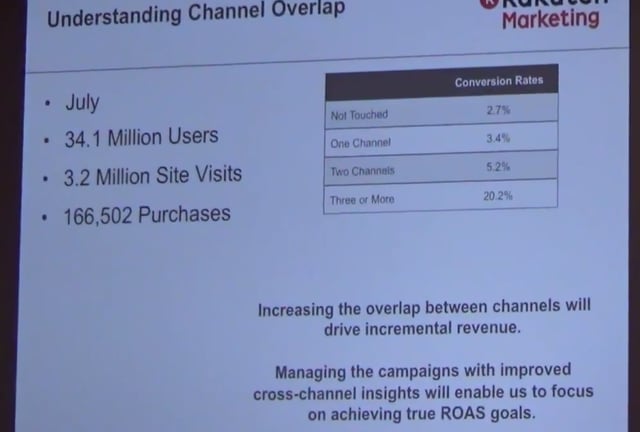 And finally, the conversion rates of both display and affiliate channels dramatically improves with channel overlap - in this example from a conversion rate of 7% and 2%, respectively, to 16%.
And finally, the conversion rates of both display and affiliate channels dramatically improves with channel overlap - in this example from a conversion rate of 7% and 2%, respectively, to 16%.
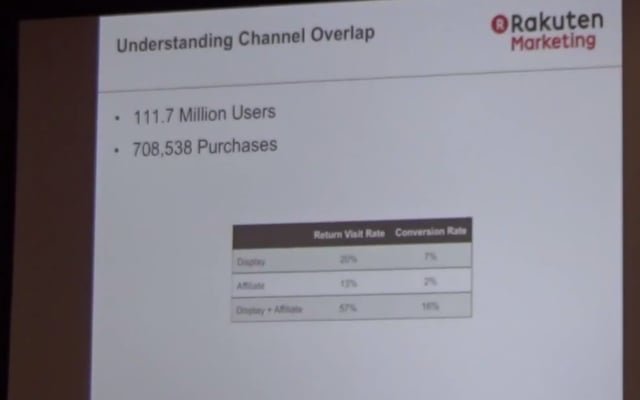 Follow Rakuten Marketing on Twitter:
Follow Rakuten Marketing on Twitter:
@RakutenMKTG_US
